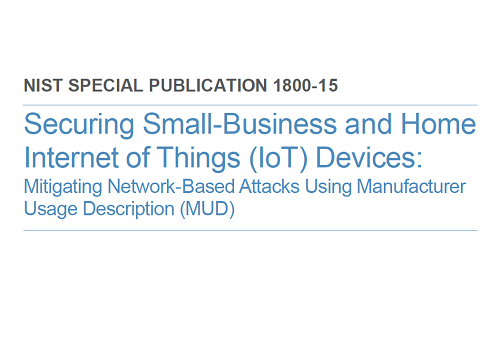REPORTS
Securing Small-Business and Home Internet of Things (IoT) Devices: Mitigating Network-Based Attacks Using Manufacturer Usage Description (MUD)
WHY WE WROTE THIS GUIDE
Gartner predicts there will be 25 billion Internet of Things (IoT) devices by 2021. While such rapid growth has the potential to provide many benefits, it is also a cause for concern because IoT devices are tempting targets for attackers. State-of-the-art security software protects full-featured devices, such as laptops and phones, from most known threats, but many IoT devices, such as connected thermostats, security cameras, and lighting control systems, have minimal security or are unprotected. Because they are designed to be inexpensive and limited purpose, IoT devices may have unpatched software flaws. They also often have processing, timing, memory, and power constraints that make them challenging to secure. Users often do not know what IoT devices are on their networks and lack means for controlling access to them over their life cycles. However, the consequences of not addressing the security of IoT devices can be catastrophic. For instance, in typical networking environments, malicious actors can detect and attack an IoT device within minutes of it connecting to the internet. If it has a known vulnerability, this weakness can be exploited at scale, enabling an attacker to commandeer sets of compromised devices, called botnets, to launch large-scale distributed denial of service (DDoS) attacks, such as Mirai, as well as other network-based attacks. DDoS attacks can significantly harm an organization, rendering it impossible for the organization’s customers to reach it and thereby resulting in revenue loss, potential liability exposure, reputation damage, and eroded customer trust.
CHALLENGE
Because IoT devices are designed to be low cost and for limited purposes, it is not realistic to try to solve the problem of IoT device vulnerability by requiring that all IoT devices be equipped with robust, state-of-the-art security mechanisms. Instead, we are challenged to develop ways to improve IoT device security without requiring costly or complicated improvements to the devices themselves.
A second challenge lies in the need to develop security mechanisms that will be effective even though IoT devices will, by their very nature, remain vulnerable to attack, and some will inevitably be compromised. These security mechanisms should protect the rest of the network from any devices that become compromised.
Download the report to find more.
SHARE:






